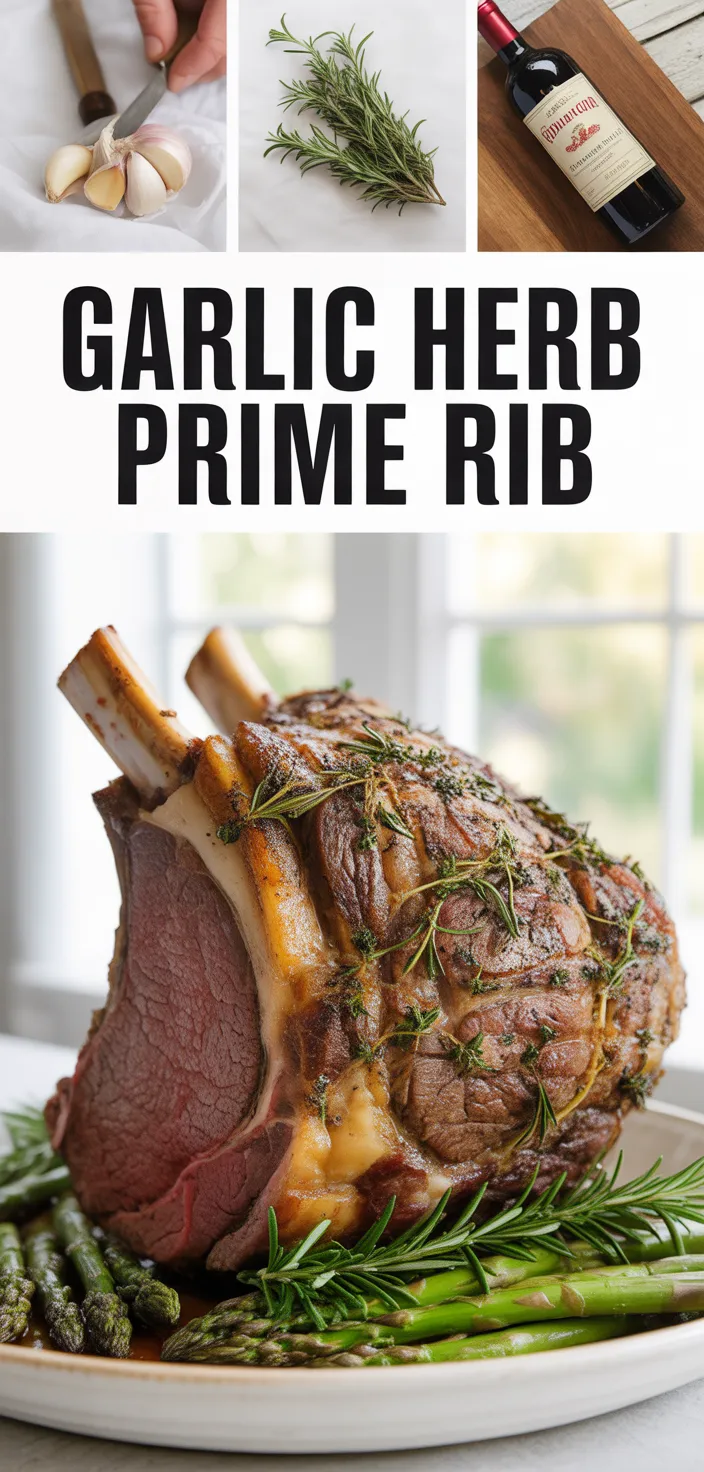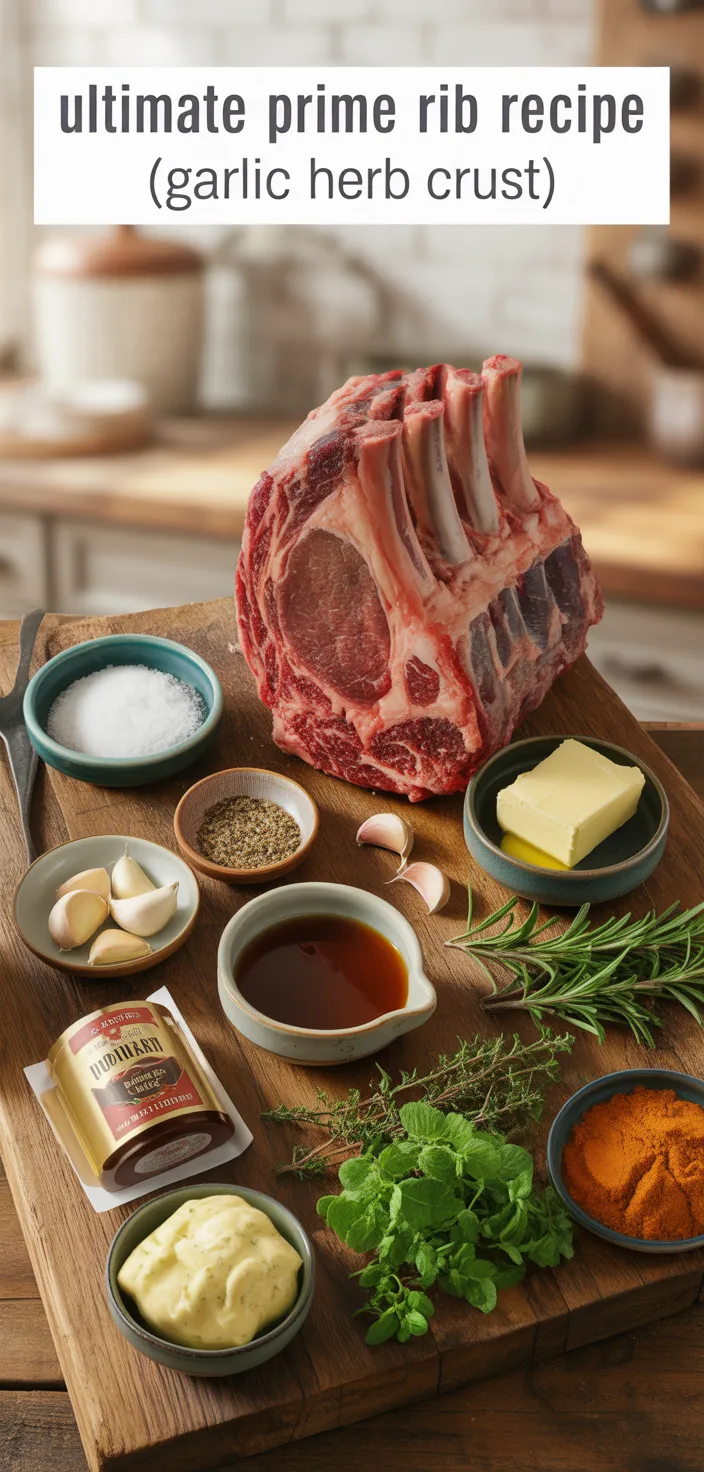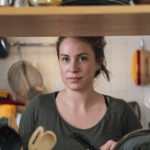I’m sharing my no-fail garlic-crusted standing beef rib roast and Prime Rib Rub Recipe so you can serve a perfectly cooked centerpiece for Christmas and any special occasion worthy of a little splurge.

I won’t sugarcoat it, I wanted a showstopper and this prime rib delivers. The garlic cloves and fresh rosemary form a crust that makes the whole roast sing, and yeah people will ask how you did it.
There’s a little arrogance in saying it’s the best but after one slice you’ll see why, juicy and almost falling apart in the middle. I kept the approach simple but bold, and even my nervous holiday guests stopped talking and just ate.
If you like tricks that make dinner look like you spent days, check the Prime Rib Rub Recipe note, you’ll thank me later.
Ingredients

- Standing beef rib roast: Rich in protein and iron, high in fat, great roast flavor but not low calorie
- Garlic: Adds sharp savory bite, small fiber, vitamin C, may aid immunity and flavor boost
- Unsalted butter or olive oil: Provides fat for crust browning, calories high, olive oil gives heart healthy fats
- Fresh rosemary: Piney herb, almost no calories, antioxidants, bright savory scent, pairs well with beef
- Fresh thyme: Earthy tiny leaves, adds depth, antioxidants present, subtle citrusy notes sometimes
- Dijon mustard: Sharp tang, adds acidity and depth, little calories, intensifies crust and flavor
- Prepared horseradish: Spicy, pungent kick, low calorie, boosts perceived leanness, classic partner for beef
Ingredient Quantities
- 4 to 6 lb standing beef rib roast bone in (prime or choice)
- 2 to 3 tablespoons kosher salt
- 1 to 2 tablespoons freshly ground black pepper
- 6 to 8 large garlic cloves smashed or minced
- 1/4 cup unsalted butter softened or 1/4 cup good olive oil
- 2 tablespoons Dijon mustard optional but really helps
- 2 tablespoons Worcestershire sauce optional
- 2 tablespoons fresh rosemary finely chopped
- 2 tablespoons fresh thyme leaves chopped
- 2 tablespoons fresh flat leaf parsley chopped
- 1 to 2 teaspoons smoked paprika optional
- 1/2 cup beef stock or au jus for serving optional
- 1/2 cup prepared horseradish or cream horseradish sauce for serving optional
How to Make this
1. Take the 4 to 6 lb standing rib roast out of the fridge 2 to 4 hours before cooking so it comes toward room temp, pat it very dry with paper towels, trim any loose flaps of fat and, if butcher didn’t tie it, tie it with kitchen twine so it keeps shape.
2. Generously season everywhere with 2 to 3 tablespoons kosher salt and 1 to 2 tablespoons freshly ground black pepper, rubbing some under the fat cap and on the bone side too; this is your chance to really flavor the meat.
3. Make the garlic herb paste: mash 6 to 8 smashed garlic cloves into 1/4 cup softened unsalted butter or 1/4 cup good olive oil, then stir in 2 tablespoons Dijon mustard (optional), 2 tablespoons Worcestershire sauce (optional), 2 tablespoons finely chopped rosemary, 2 tablespoons chopped thyme, 2 tablespoons chopped flat leaf parsley, and 1 to 2 teaspoons smoked paprika (optional). Mix until a spreadable paste forms.
4. Rub that paste all over the roast, pressing it into the meat and under the fat cap where you can; this gives you the garlic herb crust everyone raves about.
5. Put the roast bone-side down on a rack in a roasting pan and insert a digital instant-read or probe thermometer into the thickest part. Roast low at 250 degrees F until the internal temp is about 10 to 15 degrees F below your desired final temperature (rough guide for final temps: rare 120 to 125, medium-rare 130 to 135, medium 140 to 145). For a 4 to 6 lb roast this is usually about 2 to 3 hours but go by temp not time.
6. When it’s 10 to 15 degrees below target, crank the oven up to 500 degrees F and roast another 8 to 15 minutes to build a deep brown, crusty exterior and to bring the internal temp to your final target; keep a close eye so it doesn’t overcook.
7. Remove roast and tent loosely with foil, let rest 20 to 30 minutes before carving so the juices redistribute and you dont lose them on the cutting board.
8. Make quick au jus with the pan drippings: put the roasting pan over medium heat on the stove or transfer drippings to a saucepan, add about 1/2 cup beef stock or au jus, scrape up browned bits, simmer briefly and taste, strain if you like and season to taste.
9. Serve with 1/2 cup prepared horseradish or cream horseradish sauce on the side. Carve by cutting between the bones or removing bones first and slicing the roast against the grain into thick, juicy slices.
10. Quick tips: use a reliable thermometer, salt early for a dry brine effect, dont skip the rest, you can sear in a hot cast iron instead of blasting the oven if you prefer, and save the bones and trimmings for gravy or stock.
Equipment Needed
1. Large roasting pan with rack (or big cast-iron skillet if you want to sear)
2. Digital instant-read thermometer or oven probe thermometer
3. Sharp chef’s knife or carving knife and a sturdy cutting board
4. Kitchen twine to tie the roast
5. Paper towels for patting dry and trimming fat, dont skip them
6. Small bowl and rubber spatula or spoon for the garlic-herb paste
7. Tongs or a meat fork to move and hold the roast while carving
8. Saucepan for pan drippings plus a fine-mesh strainer if you want a clear au jus, and aluminum foil to tent
FAQ
Ultimate Prime Rib Recipe (Garlic Herb Crust) Substitutions and Variations
- Kosher salt
- Fine sea salt — use about 3/4 the amount by volume because it’s finer; tastes the same but packs tighter.
- Diamond Crystal or other coarse salt — use the same volume if it’s coarse, but taste and adjust.
- Celery salt — gives a subtle savory note, use sparingly (start with half the amount) because it has added flavor.
- Unsalted butter or olive oil
- Ghee or clarified butter — same buttery flavor, higher smoke point, 1:1 swap.
- Rendered beef fat or bacon fat — boosts meaty flavor, use 1:1, great if you want extra roastiness.
- Neutral high heat oil (avocado or grapeseed) — use 1:1 if you need higher smoke point, just add a pat of butter at the end for flavor.
- Dijon mustard
- Whole grain or stone ground mustard — similar tang and texture, swap 1:1.
- Prepared horseradish mixed with a little vinegar — gives heat and tang, use about 3/4 the amount of mustard.
- Yellow mustard or spicy brown — ok in a pinch, but flavor is milder so season a bit more.
- Fresh rosemary
- Dried rosemary — use about 1/3 the amount of fresh, crush it between your fingers first so it releases more flavor.
- Fresh sage or oregano — different but still savory, use equal amounts if you like a slightly earthier note.
- Extra thyme plus lemon zest — thyme is already in the recipe so adding lemon zest brightens it and replaces some rosemary character.
Pro Tips
– Salt it way ahead when you can. A dry brine 24 hours or even 48 hours in the fridge (uncovered) gives deeper seasoning and a much crisper fat cap than salting just a couple hours before.
– Use a leave‑in probe and put it in the thickest part without touching bone. If the probe touches bone you get lies, and you’ll overcook the roast chasing phantom temps.
– For the best crust try a short, screaming hot sear in a cast iron pan right after the low roast instead of blasting the whole oven. You get better Maillard flavor and more control, but watch it close so it doesnt burn.
– Tuck compound butter or herb paste under the fat cap and between joints before cooking. It flavors the interior, keeps meat moist and gives you those garlicky herb pockets that people fight over.
– Let it rest properly and slice smart. Tent loosely for 20 to 30 minutes, then remove bones first or cut between them and always slice against the grain into thick, even slices so every bite stays juicy.
Ultimate Prime Rib Recipe (Garlic Herb Crust)
My favorite Ultimate Prime Rib Recipe (Garlic Herb Crust)
Equipment Needed:
1. Large roasting pan with rack (or big cast-iron skillet if you want to sear)
2. Digital instant-read thermometer or oven probe thermometer
3. Sharp chef’s knife or carving knife and a sturdy cutting board
4. Kitchen twine to tie the roast
5. Paper towels for patting dry and trimming fat, dont skip them
6. Small bowl and rubber spatula or spoon for the garlic-herb paste
7. Tongs or a meat fork to move and hold the roast while carving
8. Saucepan for pan drippings plus a fine-mesh strainer if you want a clear au jus, and aluminum foil to tent
Ingredients:
- 4 to 6 lb standing beef rib roast bone in (prime or choice)
- 2 to 3 tablespoons kosher salt
- 1 to 2 tablespoons freshly ground black pepper
- 6 to 8 large garlic cloves smashed or minced
- 1/4 cup unsalted butter softened or 1/4 cup good olive oil
- 2 tablespoons Dijon mustard optional but really helps
- 2 tablespoons Worcestershire sauce optional
- 2 tablespoons fresh rosemary finely chopped
- 2 tablespoons fresh thyme leaves chopped
- 2 tablespoons fresh flat leaf parsley chopped
- 1 to 2 teaspoons smoked paprika optional
- 1/2 cup beef stock or au jus for serving optional
- 1/2 cup prepared horseradish or cream horseradish sauce for serving optional
Instructions:
1. Take the 4 to 6 lb standing rib roast out of the fridge 2 to 4 hours before cooking so it comes toward room temp, pat it very dry with paper towels, trim any loose flaps of fat and, if butcher didn’t tie it, tie it with kitchen twine so it keeps shape.
2. Generously season everywhere with 2 to 3 tablespoons kosher salt and 1 to 2 tablespoons freshly ground black pepper, rubbing some under the fat cap and on the bone side too; this is your chance to really flavor the meat.
3. Make the garlic herb paste: mash 6 to 8 smashed garlic cloves into 1/4 cup softened unsalted butter or 1/4 cup good olive oil, then stir in 2 tablespoons Dijon mustard (optional), 2 tablespoons Worcestershire sauce (optional), 2 tablespoons finely chopped rosemary, 2 tablespoons chopped thyme, 2 tablespoons chopped flat leaf parsley, and 1 to 2 teaspoons smoked paprika (optional). Mix until a spreadable paste forms.
4. Rub that paste all over the roast, pressing it into the meat and under the fat cap where you can; this gives you the garlic herb crust everyone raves about.
5. Put the roast bone-side down on a rack in a roasting pan and insert a digital instant-read or probe thermometer into the thickest part. Roast low at 250 degrees F until the internal temp is about 10 to 15 degrees F below your desired final temperature (rough guide for final temps: rare 120 to 125, medium-rare 130 to 135, medium 140 to 145). For a 4 to 6 lb roast this is usually about 2 to 3 hours but go by temp not time.
6. When it’s 10 to 15 degrees below target, crank the oven up to 500 degrees F and roast another 8 to 15 minutes to build a deep brown, crusty exterior and to bring the internal temp to your final target; keep a close eye so it doesn’t overcook.
7. Remove roast and tent loosely with foil, let rest 20 to 30 minutes before carving so the juices redistribute and you dont lose them on the cutting board.
8. Make quick au jus with the pan drippings: put the roasting pan over medium heat on the stove or transfer drippings to a saucepan, add about 1/2 cup beef stock or au jus, scrape up browned bits, simmer briefly and taste, strain if you like and season to taste.
9. Serve with 1/2 cup prepared horseradish or cream horseradish sauce on the side. Carve by cutting between the bones or removing bones first and slicing the roast against the grain into thick, juicy slices.
10. Quick tips: use a reliable thermometer, salt early for a dry brine effect, dont skip the rest, you can sear in a hot cast iron instead of blasting the oven if you prefer, and save the bones and trimmings for gravy or stock.





















